My time in Yangshuo didn’t end with the big sound and light show. We had majority of another day in the city, and I think I made the most of it. I’ve mentioned it before, but I am certainly the senior member of this tour group. Sometimes it just makes me feel old, but sometimes it makes me very very grateful. For instance, on the morning after the sound and light show, when I woke up in time for a 7:30 am Tai Chi class, because I hadn’t been out all night drinking. Heh. I guess this probably makes me kind of geeky, but I would much rather spend a peaceful hour learning a bit of Tai Chi on a warm morning than wake up at noon feeling like crap.
So it was that I ended up all by myself with the Tai Chi guy. He turned out to be the same one who’d done the Gung Fu class with us a few days earlier, so it was nice to see a familiar face (though I’m embarrassed to admit I can’t remember his name). We drove out to a large patio area that was surrounded by trees and a long, low building. We would have done the Gung Fu there if it hadn’t been raining, but on this morning the sky was showing patches of blue and the temperature had warmed from the day before, so it was perfect. We started with the same warm-up we’d done for Gung Fu, which is also very much like the warm-up I do for Natalie’s Killer Hotel Room Workout, so that was familiar too. Then we moved on to the first few forms.
I don’t know much about Tai Chi, but I liked what I did that morning quite a lot. Maybe I was just in a receptive mood, but it was nice to concentrate on the slow movements and on my breathing and try to not think about anything else. When my mind wandered, which was about every 2.3 seconds, sometimes it thought about how this would be a very nice way to start every day. Of course the atmosphere and the personal instruction and the pleasant weather were all miles away from a dark January morning in a one bedroom apartment somewhere cold and Canadian, but I can definitely envision finding a Tai Chi school when I get home and learning enough to be able to do one form reasonably well.
It really was a good way to start the day, but you don’t get any photos because it just didn’t seem right. I was enjoying the one-on-one instruction and didn’t really feel like interrupting the pleasant course of the lesson with a photo op. And really, isn’t it ok that some stuff is just for me? Surely you can all survive without a picture of me making a hash of the first few movements of a Tai Chi form, right?
When I got back to the centre of town I stopped at a cart selling steamed buns and picked up a couple to have as a snack before heading back to the hotel. Two large, fresh buns came to a total of ¥2.00, about 30 cents. I’m not actually a huge fan of steamed buns, but I was feeling so peaceful and content and happy with China at that point that it just seemed right and good. And it was.
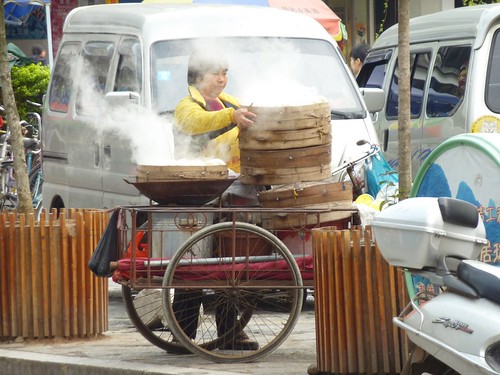 The Steamed Bun Woman. (Well your buns would be steamed too if you spent all morning like this…)
The Steamed Bun Woman. (Well your buns would be steamed too if you spent all morning like this…)
Next on the agenda that morning was a Chinese cooking class. It was scheduled for 9:30 am, and seven of us had signed up to attend. In the end only four made it – me and three of the Danes. The others simply weren’t interested in stirring from their beds after their night of debauchery (kudos to Sarah, Simone and Nanna, who are young enough that they could stay out until 3:00 am and still have the energy for cooking class). Chef Richard (another one of those English names) met us at the hotel and we walked with him over the the local market to get the last of the supplies for the day’s lesson.
The local market was very, very local. It’s been a while since I’ve been in a market, and I think this one might have been the most real one I’ve been to yet. It was divided into “dry” and “wet” sides. The dry was mostly veggies and such, including lots and lots of things that were completely unfamiliar.
 Here’s a sort of boring look at the veggie market
Here’s a sort of boring look at the veggie market
The really interesting part was the “wet” market – that’s where they sold all the meat. Of course other markets I’ve been to have sold meat. I’m no stranger to the big sides of beef and the piles of tripe and the fish heads and such. But this was the first market where the meat was so fresh it was still clucking or quacking… or woofing. It was strange to walk up to the stall where we got the main ingredient for our Kung Pao Chicken and see the cages of live chickens stacked up behind the counter. If Chef Richard had been insistent, we could have picked our bird and had it done in right there. Or we could have chosen one of the ducks sitting placidly on the floor. Luckily there weren’t really enough of us to warrant buying a whole bird, so we got a few chicken breasts that Richard assured us had only been parted from the rest of the bird about half an hour before.
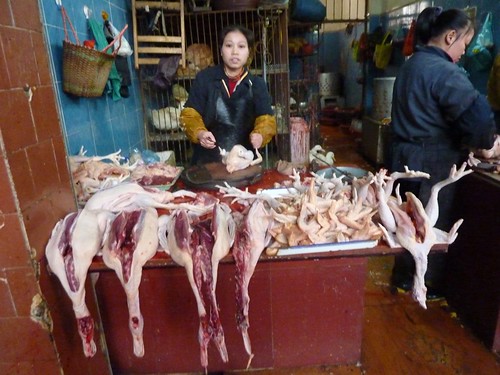 Our poultry monger. It’s a bit out of focus, because I took it sort of on the sly. They were somewhat touchy about photos in the wet market. If you really want the nasty stuff (the woofing stuff, that is) head over to Flickr.
Our poultry monger. It’s a bit out of focus, because I took it sort of on the sly. They were somewhat touchy about photos in the wet market. If you really want the nasty stuff (the woofing stuff, that is) head over to Flickr.
Chef Richard’s cooking school was a short walk from the market, and it was a big day for him. It turned out ours would be the first class he’d conduct in a new kitchen. It was a nice set-up. There was an indoor kitchen, I guess for use on chilly days, and the outdoor area we used. Both were equipped with shiny new stainless steel tables and had about twelve stations set up, each with it’s own cutting board, cleaver, gas burner and wok.
We were promised the chance to make four different dishes during our lesson – fried noodles with vegetables, pork dumplings, kung pao chicken, and the local specialty, beer fish. Richard set us up with our cleavers and gave us some basic knife lessons – the Chinese use the cleaver for all chopping, slicing, peeling, mincing and otherwise rendering food into smaller pieces than it started out in. I found this all fairly familiar – the knife was different, but the principal was the same. The Danes, though, were not so comfortable, and this made me feel old again. I guess when you’ve just graduated high school and still live at home, instead of having a decade or two of experience fending for yourself in the kitchen, you’re not so handy with the cleaver.
So we chopped and prepped and listened to Chef Richard. My favourite part was making the dumplings, and it turned out they were pretty easy too. I can actually imagine making them myself sometime. This is mostly because we didn’t bother making the dumpling wrappers. Apparently that’s not hard, just really tedious and involving lots and lots of time spent kneading the dough. Richard bought a stack of premade wrappers, so all we had to do was make the filling. I was assigned the task of mincing the pork, and it was hard. Well, not hard so much as tedious, and involving lots and lots of time spent chopping the meat. We started with a chunk of fresh pork – 70% lean and 30% according to Richard. Then it was just a matter of wailing at the meat with the cleaver for about 15 minutes until it was more like paste than anything. Then it went into a big bowl of chopped green onions and stuff and got well mixed. And the Chinese don’t mix with a spoon – they use chopsticks!
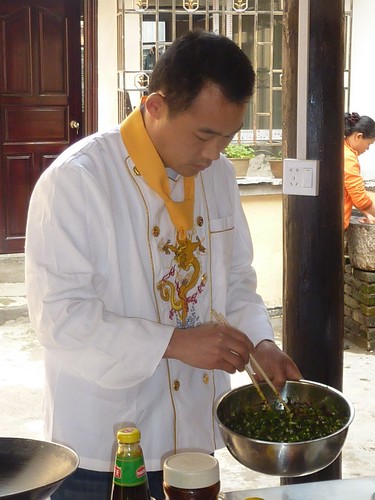 Chef Richard, mixin’ up the dumpling goop.
Chef Richard, mixin’ up the dumpling goop.
The best part was stuffing the dumplings – it took a bit of dexterity so naturally I was, well, a natural. You cradle the wrapper in one hand with a not-too-little, not-too-much amount of filling in the middle. There was also a dish of water to dip your finger in to add a bit of moisture around the outside edge so things would stick together. There’s a fold-on-top-of-fold method to crimp a bit around more than half the circumference of the circle of dough, and then you bring the unfolded side up to meet that and seal it up tight. Easy peasy.
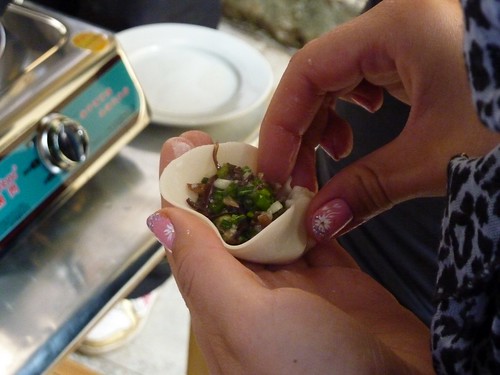 Some very fancy Danish fingernails, demonstrating the dumpling-pinching technique
Some very fancy Danish fingernails, demonstrating the dumpling-pinching technique
After the expert crimping, the dumplings went into a bamboo steamer in a wok of boiling water . And here’s a GSRED first – a recipe! Try this at home, kids.
Chinese Dumplings
(from Chef Richard of Yangshuo Dragon Chef Cooking School)Ingredients for filling:
- 100 grams green onion
- 200 grams pork (or beef or mutton)
- 150 grams wooden mushrooms (errr… I dunno)
- 3 tsp soy sauce
- 3 tsp starch flour (we used baking soda – it’s to tenderize the meat)
- 1-ish tsp salt
- a pinch of powdered chicken stock
- Cut the onions and mushrooms very small and marinade with salt, soy sauce and chicken stock, mixing for 2 minutes
- Chop the meat into small pieces and beat until very small. Marinade with salt, soy sauce, chicken stock and starch flour for two minutes
- Combine the vegetables and meat together
- Make the parcels: take a sheet of dough in your hand, place the mixed vegetables and meat in the centre and fold over to make a parcel
- Put parcels on top of a clean cloth in a bamboo steamer. Make sure they don't touch each other or they'll stick together. Putting them on a cloth stops them from sticking to the steamer.
- Steam for 10 minutes.
- For fried dumplings, steam for 6 minutes and then fry gently on low heat, turning until parcels are crispy and golden on all sides.
While the dumplings were cooking we whipped up a quick plate of fried noodles and then sat down to eat the first course. It was really good.
After having our appetizers we moved to the main courses – kung pao chicken and beer fish. They were also both pretty easy – mostly a question of having everything chopped and ready to go. Also a question of knowing when to turn up the heat and when to turn it down and when, finally to turn it off and break out the chopsticks. I’d already sampled beer fish along with my weird food, but I happen to think that the version we made in cooking class was better than what we had in the restaurant. We let the beer cook down a bit more than they must have in the restaurant because ours was less soupy and more savoury.
Perhaps because it was an auspicious day, we even got a visit from Chef Richard’s family. His wife came by with their son, and a friend, and her little girl. So we got to meet a lot of new people and see a little bit of real life. And, of course we took pictures.
 Chef Richard, and Mini Chef, who was very popular with Simone
Chef Richard, and Mini Chef, who was very popular with Simone
Cooking class ended around 1:00pm, and I slowly made my way back to the centre of town. I had the whole afternoon free because we weren’t to meet for our last overnight train trip until 6:00 pm. I had a bit of a rest in the hotel and then went back to the little used bookstore where I met once again met up, fortuitously, with Randy. I guess it’s a small enough town that it’s easy to run into people you know.
The clock wound down on our time in Yangshuo much too soon. It was a pleasant, relaxing place to visit and I could easily have spent another day or two there, doing Tia Chi in the morning, trying out calligraphy and painting and ma johng, and hanging out in the bookstore. But Hong Kong was calling loudly so we met up that evening for an annoying bus ride into Guilin, and then boarded our last overnight train of the trip. It was a thirteen hour journey to Shenzhen, the point where you cross the border out of mainland China and into the Hong Kong Special Administrative Region. Arriving in Hong Kong was fantastic – I felt like I was coming up for air for the first time in ages.
And now I’m happily ensconced in Hong Kong and it’s just as fantastic as it felt when we first arrived at the border. We had our last group dinner on the 26th, and now I’m on my own again for the first time since I arrived in Africa in December. I don’t regret my choice to do all those organized tours, but the few days I’ve had on my own here in Hong Kong have really put the spring back in my step. I’ve got a few more random things to say about China, but for now just know that I’m happy and relaxed and more enthusiastic about tackling the last chapter of this crazy adventure than I’ve been in a while.

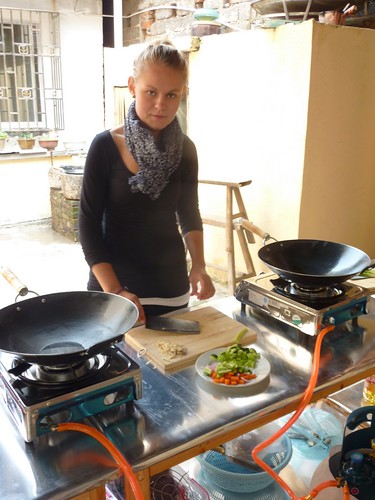



0 Comments:
Post a Comment